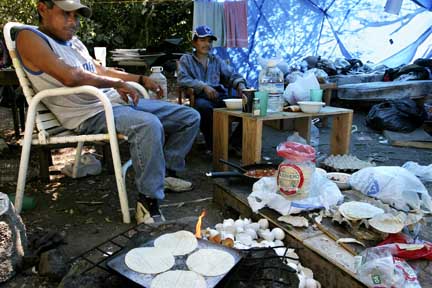Located in Downtown Berkeley, California, Addison Street Windows Gallery presents a photographic exhibition by artist, writer and activist, David Bacon. The show, entitled “Beyond Borders,” speaks to the migration of indigenous peoples from Mexico to the United States, specifically addressing a new phenomena in continental living – the creation of “transnational communities.”
In this body of work, Bacon uses his professional lens to show the very human face of people and communities often dehumanized and stereotyped, regularly treated as both an objectified commodity and a socio-political liability. And while Mexicans and other indigenous Americans in the US are often marginalized to the point of invisibility, they are ubiquitous in this nation, making up a significant portion of the vast ranks of farm workers who cultivate the food we all eat.

A sidewalk view of the installation of David Bacon's “Beyond Borders” exhibit. (Photo: Max Eternity)
“Beyond Borders” is a continuation of Bacon's work in raising awareness around immigrant rights, with this current exhibit actually being part of a larger series entitled “Living Under the Trees,” in which Bacon – over the last decade – has documented communities of indigenous migrants from Mexico, who now live in rural California towns, surviving by working corporate fields.

Mexico City, Mexico – 14 November 2008 – Teachers who have arrived in the capital from all over the country march through downtown Mexico City to the Zocalo, to demonstrate against the government's proposed education reforms. (Photo: David Bacon)

Mexico City, Mexico – 26 September 2010 – Leobardo Benitez Alvarez has been living in a tent in front of the office of the Federal Electircity Commission on the Reforma in downtown Mexico City for the past year. He and other workers in the encampment are protesting the actions of the Mexican government in firing 44,000 electrical workers and smashing their union, the Sindicato Mexicano de Electricistas (SME) in October 2009. Since then, many have been participating in protests throughout the city. (Photo: David Bacon)
In addition to his immigrant rights work, Bacon has been a union organizer “for many, many years,” he says. And perhaps it is because of his passion and commitment to people power that he is able to capture the plight of those he photographs with such deep empathy and dignity.

Oxnard, California – 20 May 2006 – Guillermina Diaz, a Mixtec immigrant from Oaxaca, picks strawberries. She and her sister support three other family members, all of whom sleep and live in a single room in a house in Oxnard, where other migrant families also live. (Photo: David Bacon)
In the faces he captures, one is struck by the suffering of people enduring harsh conditions, living out their uncertain lives in makeshift settlements, while at the same time, maintaining hope for a brighter day. These are people who continue to keep themselves together as a community, in spite of the worst adversity and exploitation.

Graton, California – 26 June 2004 – The workers are Chatinos, and use their cultural practices and family ties to support each other while looking for farm work in Sonoma County, one of the wealthiest wine-producing areas of the US. (Photo: David Bacon)
“It's not so simple that we go about documenting poverty … in order to get people to change it,” says Bacon. He and his allies “try to show the complexity of life in migrant communities.” In carrying out this mission, Bacon says that he seeks to offer viewers a perspective that represents a more complete, dynamic picture of these communities, by placing front and center “their culture, their dance traditions, their music traditions,” and of course “their food.”
“It's incredible,” he says.
“Beyond Borders” contains 29 large-format digital prints, and runs till the end of May 2011. The show is on view 24 hours a day from the sidewalk, and what follows are select clips from a recent podcast conversation with the artist, recorded at a nearby cafe.
Part One: A Conversation With David Bacon
Part Two: A Conversation With David Bacon
Part Three: A Conversation With David Bacon
Join us in defending the truth before it’s too late
The future of independent journalism is uncertain, and the consequences of losing it are too grave to ignore. To ensure Truthout remains safe, strong, and free, we need to raise $27,000 in the next 24 hours. Every dollar raised goes directly toward the costs of producing news you can trust.
Please give what you can — because by supporting us with a tax-deductible donation, you’re not just preserving a source of news, you’re helping to safeguard what’s left of our democracy.
